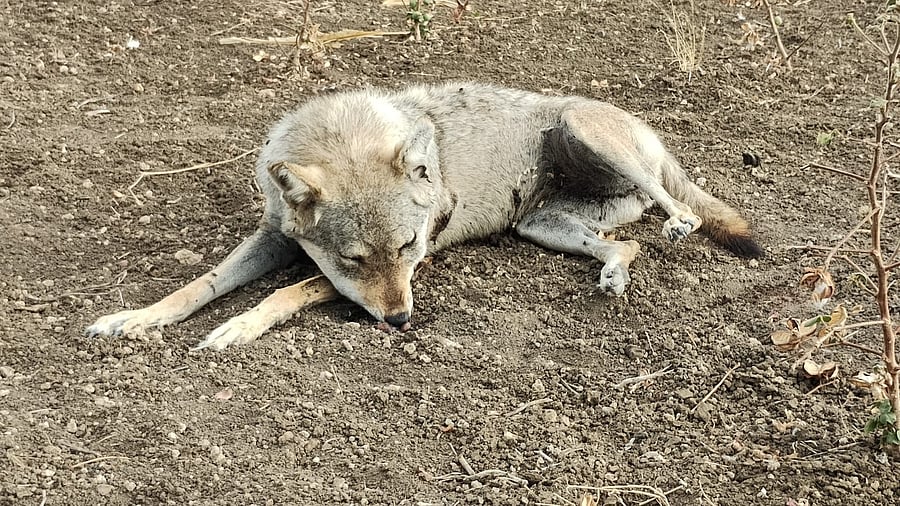
Carcass of a male wolf on the outskirts of Hubballi. It was poisoned to death by farmers.
Credit: DH FILE PHOTO BY PAVAN KUMAR H
Hubballi: For the last two decades, Karnataka has not conducted any comprehensive study or census of Indian grey wolves on its grasslands and semi-arid regions.
With the International Union for Conservation of Nature (IUCN) likely to recognise it as a new species and place it in the vulnerable category, there is renewed hope among researchers on better conservation of the top predator of the grassland. Like tigers, conservation of wolves will ensure a thriving grassland ecology that could retain and recharge groundwater tables and improve animal husbandry.
In 2001-04, when the last survey was conducted across the state by a team led by Honnavalli N Kumara, they had identified the presence of nearly 555 individual wolves in 19 districts of Karnataka. However, now the apex predators have lost several of their dwelling places and their pack size has also reduced drastically. Today, there is sporadic direct sighting of the wolves in only 12-13 north Karnataka districts. While there is no official data of adult wolves in Karnataka, experts working on the field estimate that there could be less than 400 wolves in the wild.
Experts say nearly 95% of the wolves in Karnataka are found in unprotected areas and face constant threat of diminishing prey base, human interaction and hybridisation.
"Lack of accurate data for two decades of a species that has lost its habitat significantly is a matter of concern. Without knowing their population, range and habitat it would be difficult to formulate conservation strategies," says Kumara. He says several habitats that had earlier recorded the presence of wolves, have not reported any direct or indirect sighting of the species for over several years. He gives the example of Pavagada in Tumakuru and Melkote in Mandya, where wolves were once found in good numbers.
In fact Melkote Temple Wildlife Sanctuary (1974) was supposed to be the first wolf sanctuary in Karnataka. However, for the last decade or so, experts haven't sighted a wolf in this region. Tens of wolves were hunted and culled in Pavagada taluk after the animals were 'blamed' for the disappearance of seven girls in the region.
Human intervention, especially converting grasslands and barren semi-arid regions into agriculture fields following improvement in irrigation, has adversely impacted the population of wolves as experts have recorded incidents of farmers destroying wolf dens and also killing wolf pups. Diminishing natural prey such as blackbuck and other smaller mammals have meant that wolves are forced to depend on sheep, further enhancing the chances of human-animal conflict. Windmills, solar parks and others have also encroached into wolves' roosting places.
Salvador Lyngdoh, a scientist working on wolves of Kappatgudda in Gadag, says over the years, during field observation, the sighting of wolves has been less common. "Even in protected areas such as Bankapur Wolf Sanctuary in Koppal, wolves are being sighted only when they litter pups. We don't know where these animals are ranging and what their threats and prey are. For this, we need to conduct a survey and collar tag individuals," he says.
Experts also said the size of wolf packs is reducing drastically. Vivekananda B, a forest watcher in Bidar says seven to eight years ago, he used to record wolf packs ranging from 10-13 individuals. "Now, the biggest pack that I have seen is five, two adults, one sub-adult and two pups," he says and adds that lack of natural prey is forcing the adults to flee from the pack.
Bidar, Koppal, Gadag, Raichur, Kalaburagi and Belagavi are some of the districts with sizable populations of the wolves in Karnataka.